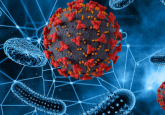Is herd immunity to COVID-19 a possibility?

As the prospect of re-entering lockdown grows in some countries, the question of pursuing herd immunity as a solution to COVID-19 has re-emerged. But what are the realities of chasing herd immunity?
As many countries in Western Europe increasingly appear to be heading towards a second lockdown, with stricter social distancing measures being introduced weekly and an ominously increasing R-rate, the question of developing herd immunity as a response to COVID-19 is once again raising its head.
The proposal of targeting herd immunity can seem appealing. Lesser restrictions obviously appeal to a population’s desire for unbridled freedom, while seemingly reducing the impact on the economy – particularly in areas such as the events and hospitality industries – by allowing a higher proportion of people to engage with businesses and spend money.
The drawback of herd immunity has been highlighted several times by different modeling studies around the world. One particularly pertinent example includes the report submitted to the UK government by Imperial College London (UK) in March, which predicted a death toll of 250,000 if the attainment of herd immunity was selected as a strategy [1].
However, it is unclear as to whether herd immunity could be obtained by closely monitoring and controlling social distancing rules to prevent the overrunning of a countries healthcare system. We are yet to know: what is the likelihood of achieving herd immunity?
Controlling COVID-19
It is exactly this question that a recent study from the University of Georgia (USA) set out to answer, using a modeling study designed to assess the chance of success of two strategies – “suppression” and “mitigation” – in the UK [2].
Suppression was defined as an attempt to, “suppress transmission in the target population,” by using strict controls such as closing offices and schools and enforcing strong social distancing measures. Continuation of these controls for a significant period of time leads to a reduction in the spread of the virus, ideally to negligible levels that make the suppression of a resurgence possible with slightly relaxed controls.
Mitigation meanwhile was defined by attempts to manage the negative health impacts of the pandemic by preventing the country’s healthcare system from being overwhelmed. This strategy would be pursued by reducing, but not halting, transmission and localizing it to a less at-risk population, decreasing the pool of people susceptible to infection to a level that prohibits the possibility of sustained infection. Again, social distancing and further restrictions would be required to implement this strategy, albeit in a significantly more relaxed manner.
 Talking Techniques | Big data and COVID-19 part 2: Affecting policy and revealing risk
Talking Techniques | Big data and COVID-19 part 2: Affecting policy and revealing risk
In this podcast episode, Digital Editor Tristan Free speaks to Amitava Banerjee, Associate Professor in Clinical Data Science at University College London about the “OurRisk.CoV Calculator”.
What are the realities of herd immunity for COVID-19?
The researchers, Tobias Brett and Pejman Rohani (both University of Georgia) used an age-stratified disease transition model of the UK to replicate the spread of COVID-19 under a variety of individual self-isolation and widespread social-distancing measures. The social distancing measures included school closures, social and workplace closures, and effective isolation by individuals in older age stratifications.
Using this modeling system, the study identified one route as providing the best chance of delivering herd immunity. First, by separating the population into two groups, over 60s and under 60s, the over 60s are required to completely self-isolate while the epidemic grows within the less at-risk under 60s group. Once hospitals reach their maximum capacity, deemed to be 100,000 hospitalized cases, the under 60s would then be required to socially distance until the R-rate stalls and reaches 1. To attain herd immunity in the shortest amount of time, the R-rate must then be controlled so that it remains stable at 1, meaning that hospitals function at maximum capacity but without being overwhelmed.
Once this balance has been struck between a maximum rate of infection and a functioning healthcare system, social distancing measures would then need to be repealed in small steps, each step increasing in impact as the pool of population susceptible to the disease decreases. This repealing process would need to occur with the utmost precision. If restrictions are lifted too swiftly, hospitals will be overrun and deaths will rise, too slowly and the decline in the infection rate will mean that the wave of infections subsides before herd immunity has been reached, leaving the population vulnerable to a subsequent future wave.
Once a significant portion of the under 60s are no longer susceptible to the virus, meaning that the infection rate begins to drop, the over 60s can then begin to be released from self-isolation. The predicted time taken to achieve herd immunity in this scenario, accounting for the capacity of hospitals in the UK, was 12 months.
Spooking the herd
As the best option to achieve herd immunity, this model leaves a lot to be desired. A full year’s self-isolation for the over 60s population would be exceptionally challenging for a large portion of society who rely on the care of younger relatives. Furthermore, the fiscal impact of sealing a section of the population that, as of 2018, contributes 53 pence in every pound sterling spent in the UK economy could also be devastating [3].
What’s more, the model is based on some fundamental assumptions that are unlikely to translate practically. The model assumes that the measures would be applied and adhered to meticulously enough to maintain the R-rate in an incredibly narrow range that represents the knife-edge between the premature suppression of the virus and the overwhelming of the UK health service. Self-isolation of the over 60s was considered to be perfect with no contact with under 60s or each other.
Another key assumption, highlighted by the study authors, is that once infected an individual is imbued with perfect long-term immunity to the virus. With patients who have been infected by SARS-CoV-2 multiple times now reported on several separate occasions, this is an assumption that is simply too great to ignore [4].
The modeling study did, however, indicate that the suppression was a feasibly attainable goal, one which could be achieved within 2 months if symptomatic individuals self-isolated effectively and reasonable levels of social distancing are observed.
On the surface of it, herd immunity can be presented as a feasible solution to COVID-19. Promises of the avoidance of the severe lockdowns observed across the world throughout the first half of this year will appeal to many for whom the depths of lockdown presented perhaps one of the most challenging periods in their lives.
However, to hang on to this hope is to misunderstand the nature of herd immunity. This is a natural phenomenon that occurs over a long period of time and acts, typically, as the endpoint for a pandemic. For many diseases, it doesn’t occur at all. The only way herd immunity can be achieved synthetically is through the systematic process of mass vaccination. With governments in a scramble to determine the path forward through COVID-19, it is time to recognize herd immunity not as a definable strategy, but as an obdurate force of nature that cannot easily be tamed and bent to our will.


